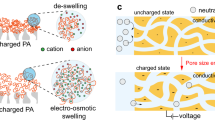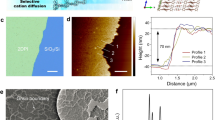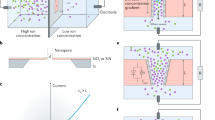Abstract
Polymer electrolyte membranes (PEMs) selectively transport ions and polar molecules in a robust yet formable solid support. Tailored PEMs allow for devices such as solid-state batteries,‘artificial muscle’ actuators and reverse-osmosis water purifiers. Understanding how PEM structure and morphology relate to mobile species transport presents a challenge for designing next-generation materials. Material length scales from subnanometre1,2 to 1 μm (refs 3, 4) influence bulk properties such as ion conductivity and water transport. Here we employ multi-axis pulsed-field-gradient NMR (ref. 5) to measure diffusion anisotropy, and 2H NMR spectroscopy5,6 and synchrotron small-angle X-ray scattering7 to probe orientational order as a function of water content and of membrane stretching. Strikingly, transport anisotropy linearly depends on the degree of alignment, signifying that membrane stretching affects neither the nanometre-scale channel dimensions nor the defect structure,causing only domain reorientation. The observed reorientation of anisotropic domains without perturbation of the inherent nematic-like domain character parallels the behaviour of nematic elastomers8, promises tailored membrane conduction and potentially allows understanding of tunable shape-memory effects in PEM materials9. This quantitative understanding will drive PEM design efforts towardsoptimal membrane transport, thus enabling more efficient polymeric batteries, fuel cells, mechanical actuators and water purification.
This is a preview of subscription content, access via your institution
Access options
Subscribe to this journal
Receive 12 print issues and online access
$259.00 per year
only $21.58 per issue
Buy this article
- Purchase on Springer Link
- Instant access to full article PDF
Prices may be subject to local taxes which are calculated during checkout




Similar content being viewed by others
References
Schmidt-Rohr, K. & Chen, Q. Parallel cylindrical water nanochannels in Nafion fuel-cell membranes. Nature Mater. 7, 75–83 (2008).
Mauritz, K. A. & Moore, R. B. State of understanding of Nafion. Chem. Rev. 104, 4535–4585 (2004).
Ohkubo, T., Kidena, K. & Ohira, A. Determination of a micron-scale restricted structure in a perfluorinated membrane from time-dependent self-diffusion measurements. Macromolecules 41, 8688–8693 (2008).
Rubatat, L., Rollet, A. L., Gebel, G. & Diat, O. Evidence of elongated polymeric aggregates in Nafion. Macromolecules 35, 4050–4055 (2002).
Li, J., Wilmsmeyer, K. G. & Madsen, L. A. Anisotropic diffusion and morphology in perfluorosulfonate ionomers investigated by NMR. Macromolecules 42, 255–262 (2009).
Rankothge, M., Haryadi, Moran G., Hook, J. & Vangorkom, L. Orientation effects in the deuterium NMR-spectroscopy of perfluorinated ionomer membranes. Solid State Ion. 67, 241–248 (1994).
Cable, K. M., Maurtiz, K. A. & Moore, R. B. Anisotropic ionic-conductivity in uniaxially oriented perfluorosulfonate ionomers. Chem. Mater. 7, 1601–1603 (1995).
Warner, M., Bladon, P. & Terentjev, E. M. Soft elasticity—deformation without resistance in liquid-crystal elastomers. J. Phys. II 4, 93–102 (1994).
Xie, T. Tunable polymer multi-shape memory effect. Nature 464, 267–270 (2010).
Gierke, T. D., Munn, G. E. & Wilson, F. C. The morphology in nafion perfluorinated membrane products, as determined by wide-angle and small-angle X-ray studies. J. Polym. Sci. B 19, 1687–1704 (1981).
Moore, R. B. & Martin, C. R. Procedure for preparing solution-cast perfluorosulfonate ionomer films and membranes. Anal. Chem. 58, 2569–2570 (1986).
Hensley, J. E., Way, J. D., Dec, S. F. & Abney, K. D. The effects of thermal annealing on commercial Nafion® membranes. J. Membr. Sci. 298, 190–201 (2007).
Lin, J., Wu, P. H., Wycisk, R., Pintauro, P. N. & Shi, Z. Q. Properties of water in prestretched recast Nafion. Macromolecules 41, 4284–4289 (2008).
van der Heijden, P. C., Rubatat, L. & Diat, O. Orientation of drawn Nafion at molecular and mesoscopic scales. Macromolecules 37, 5327–5336 (2004).
Li, J., Wilmsmeyer, K. G. & Madsen, L. A. Hydrophilic channel alignment modes in perfluorosulfonate ionomers: Implications for proton transport. Macromolecules 41, 4555–4557 (2008).
Rubatat, L. & Diat, O. Stretching effect on Nafion fibrillar nanostructure. Macromolecules 40, 9455–9462 (2007).
Hou, J. B., Li, J. & Madsen, L. A. Anisotropy and transport in poly(arylene ether sulfone) hydrophilic–hydrophobic block copolymers. Macromolecules 43, 347–353 (2010).
Park, M. J. & Balsara, N. P. Anisotropic proton conduction in aligned block copolymer electrolyte membranes at equilibrium with humid air. Macromolecules 43, 292–298 (2010).
Allahyarov, E. & Taylor, P. L. Simulation study of the correlation between structure and conductivity in stretched nafion. J. Phys. Chem. B 113, 610–617 (2009).
Majewski, P. W., Gopinadhan, M., Jang, W. S., Lutkenhaus, J. L. & Osuji, C. O. Anisotropic ionic conductivity in block copolymer membranes by magnetic field alignment. J. Am. Chem. Soc. 132, 17516–17522 (2010).
Burnell, E. E. & de Lange, C. A. NMR of Ordered Liquids (Kluwer, 2003).
Deloche, B. & Samulski, E. T. Short-range nematic-like orientational order in strained elastomers—a deuterium magnetic-resonance study. Macromolecules 14, 575–579 (1981).
Zawodzinski, T. A., Springer, T. E., Davey, J., Jestel, R. & Lopez, C. et al. A comparative-study of water-uptake by and transport through ionomeric fuel-cell membranes. J. Electrochem. Soc. 140, 1981–1985 (1993).
Zhang, Z. H., Marble, A. E., MacMillan, B., Promislow, K. & Martin, J. et al. Spatial and temporal mapping of water content across Nafion membranes under wetting and drying conditions. J. Magn. Reson. 194, 245–253 (2008).
Terzis, A. F., Snee, P. T. & Samulski, E. T. Orientational order of water confined in anisotropic cavities. Chem. Phys. Lett. 264, 481–486 (1997).
Basser, P. J., Mattiello, J. & Lebihan, D. Estimation of the effective self-diffusion tensor from the NMR spin-echo. J. Magn. Reson. B 103, 247–254 (1994).
Kirkwood, J. G. The general theory of irreversible processes in solutions of macromolecules. J. Polym. Sci. 12, 1–14 (1954).
Doi, M. & Edwards, S. The Theory of Polymer Dynamics (Oxford Univ.Press, 1988).
Yin, Y. G., Zhao, C. H., Kuroki, S. & Ando, I. Diffusion of rodlike polypeptides with different main-chain lengths in the thermotropic liquid crystalline state as studied by the field-gradient H-1 NMR method. Macromolecules 35, 2335–2338 (2002).
Hess, S., Frenkel, D. & Allen, M. P. On the anisotropy of diffusion in nematic liquid-crystals—test of a modified affine transformation model via molecular-dynamics. Mol. Phys. 74, 765–774 (1991).
Acknowledgements
This material is based on work supported by the National Science Foundation under award numbers DMR 0844933 and 0923107, and CBET 0756439. This material is further based on work supported in part by the US Army Research Office under Grant W911NF-07-1-0452 Ionic Liquids in Electro-Active Devices (ILEAD) MURI. Experiments at PAL were supported in part by the Ministry of Education, Science and Technology of Korea and POSTECH.
Author information
Authors and Affiliations
Contributions
J.L. and L.A.M. contributed major ideas to the project, collected NMR diffusion and alignment data, and wrote the primary text of the paper. J.K.P. and R.B.M. generated samples, collected SAXS data and provided interpretation and text editing.
Corresponding author
Ethics declarations
Competing interests
The authors declare no competing financial interests.
Rights and permissions
About this article
Cite this article
Li, J., Park, J., Moore, R. et al. Linear coupling of alignment with transport in a polymer electrolyte membrane. Nature Mater 10, 507–511 (2011). https://doi.org/10.1038/nmat3048
Received:
Accepted:
Published:
Issue Date:
DOI: https://doi.org/10.1038/nmat3048
This article is cited by
-
Solid-state rigid-rod polymer composite electrolytes with nanocrystalline lithium ion pathways
Nature Materials (2021)
-
A review of solvent action on oil paint
Heritage Science (2020)
-
Double helical conformation and extreme rigidity in a rodlike polyelectrolyte
Nature Communications (2019)
-
A novel heteropolyacid-doped carbon nanotubes/Nafion nanocomposite membrane for high performance proton-exchange methanol fuel cell applications
Iranian Polymer Journal (2018)
-
Hydrated proton self-diffusion study in ion-exchange membranes by MRI and impedance spectroscopy
Polymer Bulletin (2017)



